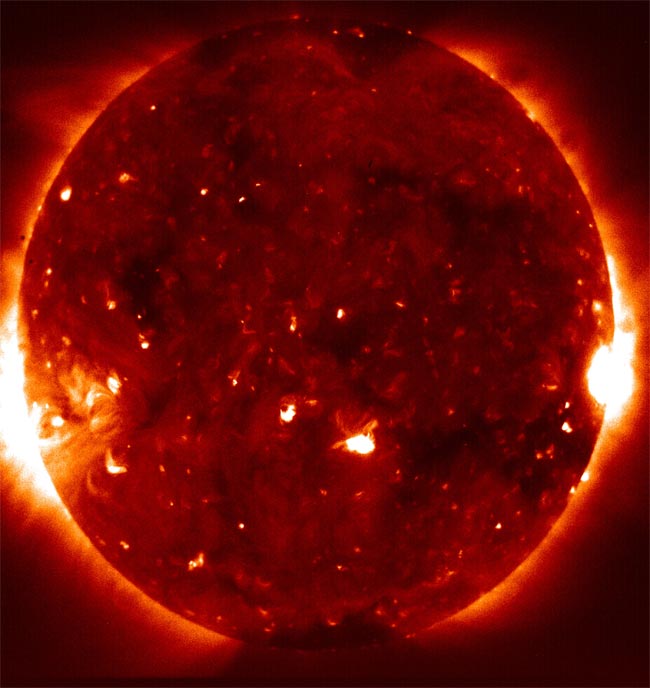Sun Might Hold Secret of Dark Matter

Theidentity of the mysterious dark matter thought to pervade the universe haseluded astrophysicists for decades. Now, for the first time a team hopes tolook inside the sun for one of the prime candidates.
The invisiblestuff called dark matter is thought to make up as much as 90 percent ofthe universe's matter. To date, astrophysicists have only inferred the existence ofsome mysterious substance by identifying its gravitational effects on visiblematter such as stars and galaxies. (For instance, dark matter makes galaxiesspin faster than otherwise expected.)
Twohypothetical particles have become the prime suspects to explain thefundamental make-up of dark matter: so-called axions and WIMPs (Weakly Interacting Massive Particles). Tens of teams areon the hunt for the heavyweight WIMPs, such as the GLAST team, which hopes todetect the gamma rays produced when, hypothetically, WIMPs and their antimatterselves annihilate each other.
Onlya handful of groups are searching for the lightweight particles called axions. For both sociological and technicalreasons, WIMP searches far outnumber axion ones, according to David Tanner, aphysicist at the University of Florida, and others. For instance, he said,detectors for WIMPs build more on the expertise of many astrophysicists. Inaddition, these massive particles are more fantastical.
"WIMPsalso imply things about supersymmetryand extra dimensions," Tanner told SPACE.com. "And so if theywere detected, they would give theorists lots of new toys to play with, and newideas to follow."
A team ledby X-ray astronomer Hugh Hudson of UC Berkeley says, however, that they areonto a promising and new way to search for the axion: Looking inside the sun.
Hudson presented his research at a recentmeeting of the American Astronomical Society (AAS) in St. Louis.
Breaking space news, the latest updates on rocket launches, skywatching events and more!
Solaraxions
The axionis extremely lightweight with neither electric charge nor spin, so it hardlyinteracts with the universe's surrounding matter ? that's if the particleeven exists.
The sun isthought to possibly be a factory for these axions. When photons at the sun'score feel a magnetic field, they become axions, the thinking goes. Since theteensy particles only weakly interact with ordinary matter, they are thought toeasily fly through the sun's core toward the surface unimpeded by otherparticles. Once at the solarcorona, where the sun's magnetic field is strong, the axions would convertback into photons.
It's thesephotons that Hudson's team hopes to find using existing instruments on threesatellites capable of observing solar X-rays: Yohkoh, RHESSI and Hinode.
The X-rayimages to date, Hudson said, have turned up empty of axion signatures. He andhis team hope to increase the sensitivity of their searches by combining lotsof images to yield, potentially, a stronger, composite signal. The compositeimage would help the astrophysicists to get rid of so-called background noiseproduced by everything else but the axions.
Thesearch is on
Other axionsearches are ground-based.
The CERNAxion Solar Telescope in Geneva aims to detect axions from the sun's super-hotcore. Hypothetically, the axions should hit the telescope's superconductingmagnet (and associated magnetic field). The axions would transform back intophotons due to the magnetic field. An X-ray detector would then pick up theX-ray signal of these photons.
And in theAxion Dark Matter Experiment at Lawrence Livermore National Laboratory in California, astrophysicist Karl van Bibber and his colleagues hope to create their ownaxions. They are manufacturing intense magnetic fields in the hopes ofdetecting microwave signals of an axion decaying into a single, real photon.
"Theaxion is so light that it doesn't decay into two photons in free space.However, you can play a very remarkable trick," van Bibber said. "IfI shoot a photon into a magnetic field (which you can think of as a sea ofvirtual photons), a real photon and a virtual photon [interact] to make anaxion and vice versa."
Pendingaward
Whetherit's made of axions or WIMPs, or something else, the invisible stuff seemsto be everywhere.
"Everyonein the business agrees that there is an unknown particle that is the darkmatter of both the universe and of our galaxy," Tanner said."Galaxies have a halo of dark matter, so their mass is much greater thanthe mass of the luminous stars in them."
If Hudson'sor another team were to reel in axions, the announcement that they are the darkmatter particle would not immediately follow. For one, evidence that axionsexist would not exclude the existence of WIMPs, van Bibber said.
"Itmight be that we live in a universe that is kind of a cocktail, that it mightbe 90 percent WIMPs and 10 percent axions, or fifty-fifty or something likethat," van Bibber said.
That's notideal, of course. "Nobody knows and nobody is so dogmatic as to say thatmy type of dark matter is the only type," Tanner said. "One hopesthere aren't thousands of types of dark matter because that makes the problemvery messy."
Loveaffair
Even withthe odds of detectingdark matter not in their favor, astrophysicists maintain an unwaveringoptimism.
"Ithink if one were not optimistic, one would probably throw in the towel. I thinkI'm an optimist about that. I think I expect someday the phone will ring andsomebody will say 'Did you hear that so and so found the axion?'" vanBibber said during a telephone interview. "And they will do it in a cleverway that we hadn't thought about. I'm expecting to be surprised, because itwill be found in a pleasantly unsuspected way."
Hedescribes his search for the axion as one involving romance. "Personally,it's like any love affair, you kind of get smitten," he said. "I'vebeen smitten for about 20 years now."
For Hudson, solar axions hold another prize, a window inside the sun.
"Itwould be revolutionary for solar and stellar physics to be able to make use ofthe axions, if real, to see inside the sun," Hudson said, "and alsoto study the coronal magnetic field via the conversion process [of axions tophotons]." Axions could help astrophysicists to make more accuratemeasurements of the temperature of the sun's core, for instance.
- Video: Dark Matter in 3-D
- Vote: The Strangest Things in Space
- Greatest Mysteries: Where is the Rest of the Universe?

